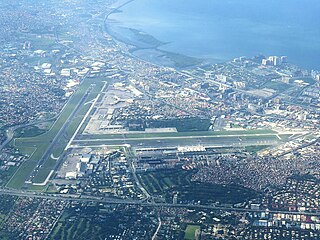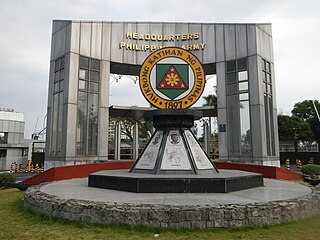
Benigno Simeon Aquino III, also known as Noynoy Aquino and colloquially as PNoy, was a Filipino politician who served as the 15th president of the Philippines from 2010 to 2016. The son of assassinated politician Benigno Aquino Jr. and 11th president Corazon Aquino, he was a fourth-generation politician as part of the Aquino family of Tarlac.

Ninoy Aquino International Airport, originally known as Manila International Airport (MIA), is the main international airport serving Metro Manila in the Philippines. Located between the cities of Pasay and Parañaque, about 7 kilometers (4.3 mi) south of Manila proper and southwest of Makati, it is the main gateway for travelers to the Philippines and serves as a hub for PAL Express, and Philippine Airlines. It is also the main operating base for AirSWIFT, Cebgo, Cebu Pacific, and Philippines AirAsia.

The Department of Transportation is the executive department of the Philippine government responsible for the maintenance and expansion of viable, efficient, and dependable transportation systems as effective instruments for national recovery and economic progress. It is responsible for the country's land, air, and sea communications infrastructure.

The Department of Tourism is the executive department of the Philippine government responsible for the regulation of the Philippine tourism industry and the promotion of the Philippines as a tourist destination.

Fort Andres Bonifacio is the site of the national headquarters of the Philippine Army located in Taguig, Philippines. The camp is named after Andres Bonifacio, the revolutionary leader of the Katipunan during the Philippine Revolution.

Bay City, also known as the Manila Bay Freeport Zone and Manila Bay Area, is the name for the reclamation area on Manila Bay located west of Roxas Boulevard and the Manila–Cavite Expressway in Metro Manila, the Philippines. The area is split between the cities of Manila and Pasay on the north side and Parañaque on the south.

Entertainment City, also known as E-City, is a gaming and entertainment complex under development by PAGCOR spanning an area of 8 km2 (3.1 sq mi) in Bay City, Metro Manila, Philippines. It was first envisioned by PAGCOR in 2002. Alongside the Aseana City business development, it lies at the western side of Roxas Boulevard and south of SM Central Business Park, part of Parañaque.
In the Philippines, a government-owned and controlled corporation (GOCC), sometimes with an "and/or", is a state-owned enterprise that conducts both commercial and non-commercial activity. Examples of the latter would be the Government Service Insurance System (GSIS), a social security system for government employees. There are 219 GOCCs as of 2022. GOCCs both receive subsidies and pay dividends to the national government. A government-owned or controlled corporation is a stock or a non-stock corporation, whether performing governmental or proprietary functions, which is directly chartered by a special law or if organized under the general corporation law is owned or controlled by the government directly, or indirectly through a parent corporation or subsidiary corporation, to the extent of at least a majority of its outstanding capital stock or of its outstanding voting capital stock.

The NAIA Road, formerly known and still commonly referred to as the MIA Road, is a short 8-10 lane divided highway connecting Roxas Boulevard and the Manila–Cavite Expressway (R-1) with Ninoy Aquino International Airport (NAIA) in southwestern Metro Manila, Philippines. It is also a major local road that links the cities of Pasay and Parañaque running approximately 2.5 kilometers (1.6 mi) underneath the elevated NAIA Expressway from R-1 in Tambo, Parañaque to NAIA Terminal 2 in Pasay. En route, it intersects, from west to east, Quirino Avenue, Domestic Road, and Ninoy Aquino Avenue. The road ends at the entrance of NAIA Terminal 2.

Gambling in Metro Manila has been regulated since 1976 when the Philippine Amusement and Gaming Corporation (PAGCOR) was created through Presidential Decree 1067. Under its charter promulgated in 1983, the 100% state-owned PAGCOR, running under the direct supervision of the Office of the President, serves three crucial roles: to regulate and operate all games of chance in the country, particularly casino gaming; generate funds for the government's infrastructure and socio-civic projects; and boost local tourism.

New Clark City is a planned community currently undergoing development, located within the Clark Special Economic Zone in the towns of Bamban and Capas in Tarlac province, Philippines. It has an area of approximately 9,450 hectares and will accommodate up to 1.2 million people. It is owned and managed by the Bases Conversion and Development Authority (BCDA).

Sangley Point Airport, also referred to as Cavite Airport, is a domestic airport at Sangley Point, Cavite City in the Philippines primarily serving general aviation and turbo-propped airliners in the general vicinity of South Luzon and the Greater Manila Area.
The Dengvaxia controversy occurred in the Philippines when the dengue vaccine Dengvaxia was found to increase the risk of disease severity for some people who had received it.
The Old Nayong Pilipino, officially the Nayong Pilipino Cultural Park, was a cultural theme park near Ninoy Aquino International Airport in Pasay, Metro Manila.

The Nayong Pilipino Clark is a cultural park featuring themed areas of Filipino culture at the Clark Freeport Zone in Mabalacat, Pampanga.
New Manila International Airport, also known as Bulacan International Airport, is an international airport under construction on the coastal areas of Bulakan, Bulacan, 35 km (22 mi) north of the capital Manila. The project was proposed by the San Miguel Corporation (SMC) and is set to help decongest Ninoy Aquino International Airport (NAIA), the main gateway to the capital for air travelers.

Santo Niño is an administrative division in southern Metro Manila, the Philippines. It is a barangay in the city of Parañaque immediately surrounding Ninoy Aquino International Airport on its west and south sides. A large portion of the village extends into the property of the airport grounds to include Terminal 1 as well as the western half of Runway 06/24. The village has a total land area of 245.97 hectares of which about 55% is occupied by the airport complex. Its population is concentrated in the areas along the Estero de Tripa de Gallina.
The Nayong Pilipino Cultural Park and Creative Hub is a planned cultural theme park to be built at the Entertainment City in Parañaque, Metro Manila, Philippines.

Philippine Village Hotel is an abandoned hotel located within the Nayong Pilipino Complex, next door to Ninoy Aquino International Airport, in Pasay City, Metro Manila, Philippines. Designed by National Artist Juan Nakpil, it was hailed as the first airport hotel in the Philippines.















